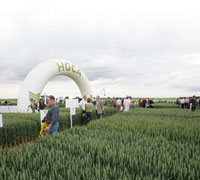Crop Watch: New varieties generate interest at Cereals

The latest varieties and fungicide chemistry on show at Cereals 2010 has got some of our Crop Watch reporters thinking.
David Cairns from McCreath Simpson and Prentice looked at wheat varieties suitable for northern growing conditions and markets when he visited the event last week. “Beluga and Invicta stood out as ticking the boxes and I will follow these until harvest with interest,” he said.
New carboxamide fungicide chemistry on show was also exciting as it offered new active ingredients to play with. “We must learn from the past and use these responsibly to avoid them breaking down quickly.”
Looming T3 sprays should not be ignored and would help maintain grain quality and green leaf area, he said. “We will be using prothioconazole or tebuconazole in conjunction with a strobilurin to finish these crops off. Yellow rust is still at the back of my mind, and hopefully this spray will allow maximum grain fill.”
Devon Crop Watch agronomist Neil Potts from Matford Arable Systems was disappointed by the lack of wheat varieties suited to his area when he visited Cereals. “The bulk of the varieties on the HGCA list are of little relevance to us in the south-west, where septoria resistance and yield are most important. Unfortunately, the choice is either yield or resistance.”
Recent showers meant the need to apply a T3 fungicide was becoming increasingly likely, particularly for those growing wheat after maize, he said. “If we get anything like normal rainfall over the flowering period and before harvest, the self assessment for mycotoxins will be almost impossible to pass without applying a T3.”
In the east, most wheat crops had escaped orange wheat blossom midge infestation, said Prime Agriculture agronomist Marion Self from Norfolk. “However, wet and warm conditions during flowering will have provided good conditions for fusarium infection and late septoria infection.”
In wheat and pulses growers should keep an eye out for aphid colonies that could build quickly in warm temperatures, he said. “In pulses, if a second fungicide is outstanding check whether an additional aphicide is required.”
Sugar beet had responded quickly to moisture and many crops would meet across rows this week. “Look out for late germinating weeds such as fat hen and volunteer oilseed rape in backward crops.”
Late rain in the Sussex area allowed spring crops to fill in, but it meant some linseed and spring bean crops would have two different growth stages, said Tod Hunnisett from Chichester Crop Consultancy. “The rain has also triggered a germination of broadleaved weeds and spring wild oats. On top of less than effective residual herbicides and poor efficacy of sulfonylurea herbicides, this will no doubt lead to some tatty crops come harvest time.”
Click below to read the full reports:
Crop Watch north: David Cairns
Crop Watch south: Tod Hunnisett
Crop Watch east: Marion Self
Crop Watch west: Neil Potts

